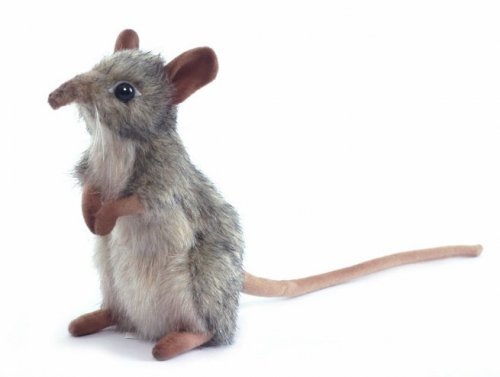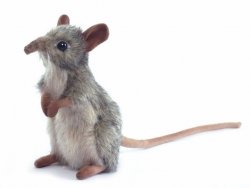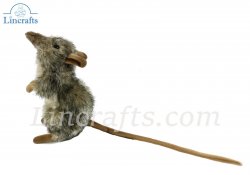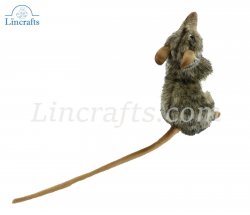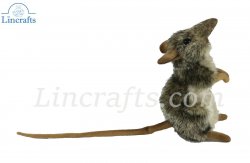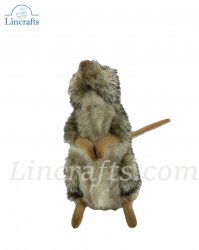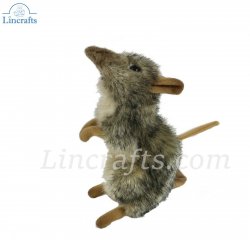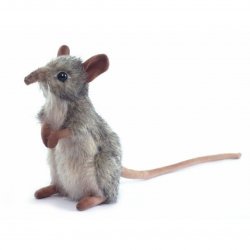Delivery
Returns
Soft Toy Rodent, Elephant Mouse (Shrew) by Hansa (14cm) 4111
Read More
Product description
This Elephant Mouse by Hansa is made from a grey and flecked plush fabric with a lighter belly and a smooth tail, ears and feet.
It is made to the highest standards from the finest materials and carries the CE label so it is safe for children and is surface washable.
Size approx. 7"(18cm) tall with the tail being 8"(20cm) in length.
Dimensions in cm.
L 11 W 8 H 18
- European safety standards EN71 BS5665
- Carries the CE label so it safe for children (not under 36 months)
- Surface washable
- Quality item with airbrushed details
Shrew Facts
Elephant shrew is small mammal that, despite its name, belongs to the group of animals called sengis. Elephant shrew is more closely related to aardvarks, elephants, moles and tenrecs than to true shrews.
There are 19 species of elephant shrew that can be found all over Africa. Elephant shrews can survive in various habitats: jungles, forests, dense woodlands, shrublands, savannahs, open plains, grasslands, semi-arid areas, deserts and mountains. Major threat for their survival is habitat fragmentation. Golden-rumped elephant shrew is the only species of elephant shrew that is classified as endangered.
Interesting Elephant Shrew Facts:
Elephant shrew can reach 4 to 12 inches in length and 2 to 18 ounces of weight.
Elephant shrew has fuzzy fur that can be white, yellowish-brown, grey, brown or black, depending on the species.
Elephant shrew has elongated, pointed head, very long, trunk-like nose (hence the name "elephant shrew"), large ears and eyes, long hind legs and long, scaly tail.
Elephant shrew can jump like a rabbit, up to 3 feet into the air, which is why it is also known as "jumping shrew".
Elephant shrew is terrestrial creature (it spends its entire life on the solid ground).
Elephant shrew is active during the day (diurnal animal).
Elephant shrew hunts and eats insects (such as ants and termites), worms, grubs and spiders using its long tongue.
Elephant shrew creates series of tiny paths on the ground and waits until prey appears. It uses excellent sense of hearing, smell and eyesight to detect both food and predators.
Cleared areas on the ground also serve as exit routes in the case of danger. When it is confronted with predators, elephant shrew often bangs the ground with its legs and tail.
Natural enemies of elephant shrews are snakes, lizards and birds of prey.
Elephant shrews live in pairs (that mate for a lifetime) and they occupy territory of a few acres, but spend most of the time alone (they gather only to mate).
Elephant shrews use scent glands under the tail to mark their trails and point out toward direction of food. They aggressively defend their territory against other elephant shrews (both males and females scream and fight with intruders). Females have menstrual cycle that resembles the menstrual cycle of a woman. They produce several litters per year. Pregnancy lasts 45 to 60 days and ends with 1 or 2 babies which spend first few days in the nest. Mashed insects are introduced at the age of 5 days (while babies are still on a milk-based diet). Young elephant shrews become ready to seek food on their own at the age of 15 days and to reproduce at the age of 41 to 46 days.
Elephant shrew has an average lifespan of 2 to 4 years.
Delivery & returns
Delivery
Orders will be dispatched within 1 working day, same day if ordered before 8.30am, by either FedEx (to available areas Royal Mail Tracked where not) or within 1 working day by Special Delivery (or FedEx next working day Mon - Fri) if express delivery is chosen at checkout to mainland UK. Express delivery is not available for a Saturday delivery.
Click here to read Sparkle's Delivery Policy
Returns
Any items returned must be in original condition with all tags attached within 30 days.
We will notify you upon receipt and the appropriate refund will be authorised as per the Distance Seller Regulations.
Please contact us prior to returning the item to the following address and include a copy of the order.
Lincrafts
Horizons
High Toynton
Horncastle
LN9 6NL

